The most exciting thing at Google IO 2018 was also the most practical
Opinion: show me where to go
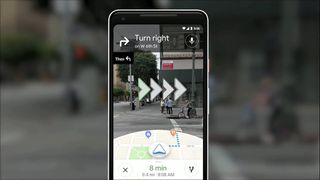
‘Head South on Montgomery Street.’
Sure thing, Google Maps. I just have to figure out which way South is.
Anyone who’s ever used Google Maps walking navigation has run into this situation. I have, lots of times. In fact, it happened to me just this morning as I was hurrying to an appointment in San Francisco, one of the most difficult cities to orient yourself in, even if you’ve been going there all your life, like I have.
The streets of San Francisco will always find a way to test you, especially when you find yourself standing on a street corner, clutching your phone and trying to decide which way you should turn so that you are, indeed, heading North on Clay Street.
Sometimes you get lucky, and you end up walking on the proper path to get you to your destination, but it's usually thanks to a mix of intuition and sheer luck.
Other times, you walk several yards or more in the direction you think the blue dot is telling you to go, even cross a street or two, before it reorients itself and you realize you’ve been walking the wrong way all along.
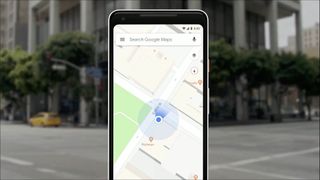
There are few things more frustrating than realizing you’ve walked in the complete opposite direction of the blue dotted line when you’re running late to a meeting.
Get daily insight, inspiration and deals in your inbox
Sign up for breaking news, reviews, opinion, top tech deals, and more.
Google knows this pain all to well, and during its mega developer conference, known as Google IO 2018, this week in Mountain View, California, the company announced it’s working on a solution.
For me, this turned out to be the most exciting thing unveiled at this year’s IO.
AR to the rescue
A new Google Maps walking navigation feature will use your phone’s camera, artificial intelligence (AI) and augmented reality (AR) to give you a real-world view of your surroundings.
Arrows overlain onto the landscape will tell you which way to go while still allowing you to see everything that’s going on around you.
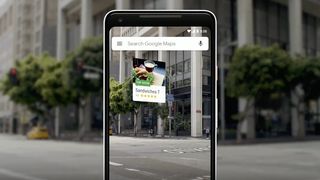
You’ll also see little cards that identify landmarks and restaurants, acting as a sort of virtual tour guide, but also helping you to get your bearings.
The new experience will use something Google is calling a visual positioning system (VPS) to scan what’s around you, and then match what it sees with Google Maps’ Street View imagery.
You’ll then receive cues (arrows, etc.) to tell you which way to go. Google is even experimenting with a cartoon AR guide to show you the way.
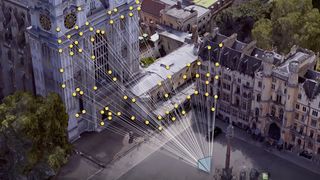
As for when we can get walking with the new Maps feature, Google tells us it plans to launch the new experience in select cities later this year.
What excited me about this is not just that it brings world-scale AR to Google Maps, but that it’s also a practical solution to an everyday problem, one I encounter at least several times a month, and often when I’m in a state of stress.
It also serves as a reminder that sometimes the simplest, most practical solutions to everyday problems can have the most meaningful impact on our lives.
A more subtle form of wizardry
While the innovations coming to Maps were, in my opinion, the most exciting bit of software unveiled at Google IO, it wasn't alone.
Another technology, called Google Duplex, rightfully garnered praise, excitement and criticism in equal measure.
Here’s what happened: Google Duplex, a new AI agent that can make phone calls for you, held conversations with real people who had no idea they were talking to a machine.

It was mind-blowing, and we’ve written lots about it. It’s an amazing and, for some, scary advancement, one that could eventually replace humans in certain situations.
While this kind of wizardry is making headlines – again, rightly so – I’m just as taken with how AR in Google Maps will have a wildly useful impact on my life.
Google Duplex, though impressive, is designed to perform a certain set of tasks; as Carrie Marshal explained for TechRadar, it won’t have a conversation with your mom for you (or, at least, not a very good one), but it can book a table for your at a restaurant.
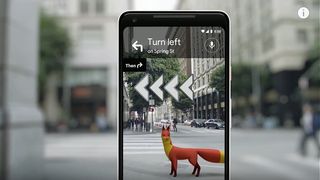
What's more, Google Duplex is likely a few years out from public release. Though beta testing is supposed to begin this summer, it's doubtful Google will roll Duplex out to the general public any time soon.
From a ‘something I’ll use everyday’ standpoint that’s much closer to deployment, AR-based walking navigation wins out over having an AI make phone calls for me.
The new walking experience isn’t the only Google Maps update announced this week. Other items include a new group planning feature and a new ‘For You’ tab so you can keep an eye on events and other happenings you might be interested in that are taking place near you.
Google Maps, which is already a helpful platform, is taking steps to get even better. By adding AR-based walking navigation and solving a real problem I face regularly, it’s taking steps to be even more enchanting, too.
Michelle was previously a news editor at TechRadar, leading consumer tech news and reviews. Michelle is now a Content Strategist at Facebook. A versatile, highly effective content writer and skilled editor with a keen eye for detail, Michelle is a collaborative problem solver and covered everything from smartwatches and microprocessors to VR and self-driving cars.
Most Popular

